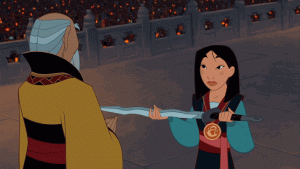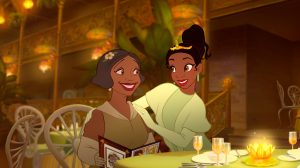
“I’ll Make a Man Out of You”: Carnival and Gender Roles in Disney’s Mulan
“Popular culture has often been a kind of carnival, a place where ordinary people set aside the usual rules and hierarchies and, in fits of liberating bad taste, rebel against (or temporarily take place of) their kings and bosses and masters”
The premise seems clear: a girl transforms into a boy so she can pose as a soldier to protect her ailing father from having to serve in the army, and saves her country. Clearly, the normal gender hierarchy and rules are upended in this story, right? Wrong. Disney’s Mulan, which takes place in early China, does not fight back against Chinese gender norms, despite appearing to do so on the surface; instead, it supports stereotypes and traditional roles. This movie is praised for its progressiveness and promotion of female empowerment, but nothing in society fundamentally changes through its duration. Mulan is only able to achieve success after posing as a man, receiving a man’s training, and becoming accepted by other men. Furthermore, after she saves China, she returns to her prescribed female lifestyle. Mulan demonstrates how seemingly progressive aspects of pop culture are deceivingly good at reinforcing norms and hierarchies.

In order to examine how Mulan reinforces society’s rules, we must first examine the work of Mikhail Bakhtin. Bakhtin would oppose the argument this essay will present; in Rabelais and His World, he describes pop culture as a “carnival” where people abandon the principles that usually guide their lives. He defines carnival as cultural events in which “the suspension of all hierarchical rank, privileges, norms, and prohibitions” (87) occurs. Further, he claims that during carnival “a second life, a second world of folk culture is thus constructed; it is to a certain extent a parody of the extracarnival life, a ‘world inside out’” (88). Bakhtin claims that society’s typical rules and structures flip during carnival, which allows people and groups to play different roles than they normally do. Since Bakhtin thinks of carnival as cultural, it follows that he believes pop culture embodies these principles.
If Bakhtin’s argument were fully correct, we would find a complete shift in social norms and hierarchy in Mulan. Superficially, this does seem to be the movie’s premise. Scholars such as Nandini Maity argue that she defies gender norms:
Although the film Mulan has a very strong undertone of a woman’s obligation, the main character takes on traits that are stereotypically for men and breaks the traditional stereotypes. Mulan can do more than cook, clean and look beautiful. She takes a direct role in her attempts to enter the world of man as opposed to passively waiting to be saved.[1]
Yes, the idea that Mulan is able to pose as a man, become a skilled soldier, and lead other men in saving her country from the Huns does seem to be the ultimate feminist storyline, does it not? However, let us look at this movie more deeply and uncover how it reinforces the gender constraints it claims to destroy.
One of the hit musical numbers from Mulan is the song “I’ll Make a Man Out of You”. During this song, Mulan transforms from a helpless failure into a skilled solider. All of the army recruits receive a proper man’s education under the guidance of General Li Shang, who is the epitome of masculinity – a strong, strategic, unemotional solider. This “man’s education” entails learning archery, hand-to-hand combat, how to shoot rockets, etc. While Mulan has already physically transformed herself into a man, this song is the point where she begins to play a man’s role.
This transformation shows how this song is counter to Bakhtin’s argument that pop culture undermines existing social hierarchies. While Mulan develops male qualities and skills, nothing in society has actually changed – the women are still viewed as weak, and the men are viewed as dominant. In this song, General Shang even asks the weak soldiers “did they send me daughters when I asked for sons?”[2] If Bakhtin were correct and the norms were completely flipped, wouldn’t the quote be “did they send me sons when I asked for daughters?” Mulan herself participates in a type of “subcarnival” in which she as an individual temporarily defies gender roles, but the roles themselves are not rethought or remade – she is only able to move between them because she is in disguise. Scholars have in fact noted, “Mulan’s heroics occur mostly during the half of the movie that she serves as a male soldier, and only with indispensable help from [other] male characters.”[3] That she must be masculinized to become strong shows that Bakhtin is incorrect – nothing about culture has been fundamentally changed, and if Mulan had not been trained to be a man, she would not have been able to save the emperor and the Chinese people.
Another song that refutes Bakhtin’s thesis is the song “A Girl Worth Fighting For”. In this song, the soldiers march off to war while singing about finding a girl who makes the war worth fighting in. The various male characters list off traits they are searching for in a girl:
I want her paler than the moon with eyes that shine like stars
My girl will marvel at my strength, adore my battle scars
I couldn’t care less what she’ll wear or what she looks like
It all depends on what she cooks like.[4]
When asked what she’s looking for in a girl, the undercover Mulan asks “how ‘bout a girl who’s got a brain/Who always speaks her mind”[5] to which the responses are all “no”. This shows that the respect Mulan has earned is artificial. If she were to reveal her true identity, the other soldiers would automatically begin to treat her as a subordinate. This is proven true when the other soldiers find out that Mulan is a woman after she saves them all from an ambush by the Huns. She is immediately shunned even without though her strength and intellect everyone would be dead. Thus, contrary to what Bahktin would say, nothing has even temporarily changed in how men and women are viewed; all that has changed is how Mulan is viewed because she is pretending to be something she is not.
Another important aspect of Mulan to consider is that after accomplishing unthinkable feats, the title character returns home to her domestic, feminine life. After she saves the emperor, he offers her a job but “she tells [him] that she must turn down his offer to serve China as a high-level council member, presumably to fulfill her traditional domestic role that has been portrayed as full of sexist prescriptions like beauty norms.”[6] Additionally, after Mulan declines his offer, the emperor gives her a sword, which she immediately bestows on her father upon her return home. This demonstrates how everything that this “feminist icon” does throughout the movie is for a man. What about this is defying gender norms? This reminds the audience that she is nothing more than “a temporary impostor in the male world”[7] and nothing about women’s role in society has changed even temporarily. Further, the movie concludes with her marrying a man and settling into the domestic life she was struggling to fit into in the first place. In fact, the entire journey she goes through actually eases her transition into domestic life – at the beginning of the movie, she is denied a match by the matchmaker because she is not an ideal wife with feminine qualities, but at the end, she is ready to settle into her wifely routine. This sends the message that if you let rebellious young girls have their fun for a bit, they will eventually settle into their preordained roles.

In thinking of how Mulan rejects Bahktin’s ideas, one quote from the movie stuck with me. At the end, after Mulan saves China and leaves for home, the emperor turns to General Shang and says, “You don’t meet a girl like that every dynasty.”[8] This is central to what I have been arguing – the idea that Mulan’s heroics are so far outside of the norm for females proves that nothing in society has fundamentally changed during this movie. Even though Mulan saved all of China, she is only held in comparison to other girls, not other skilled soldiers. In addition, her identity is reduced to her prospects as a romantic partner. Why must she end up with any man at the end of the movie? Why, after earning the respect of all of her fellow citizens, is the conclusion of this movie that she is an above-ideal potential spouse? This is not flipping society upside-down as Bahktin would expect; this is showing that no matter what Mulan has accomplished, the standards by which she will be evaluated are still restricted. No wonder she falls back into a life of domesticity – if this is how others think of her after she saves all of China, how could she ever truly have a chance to escape the norms that entrap her?
While I have shown that Mulan reinforces gender roles and norms within its universe, these also extend beyond the movie and into our world. Mulan, along with The Princess and the Frog and Moana, is considered to be one of the most female-empowering Disney movies; all three of these films focus on strong female figures.


However, Mulan and The Princess and the Frog brought in significantly lower incomes than other Disney princess movies of the time.[9] While Mulan made a relatively strong income in theaters – “$121 million gross domestic total, all-time domestic rank: 446, and much greater foreign box office receipts of $184 million”[10] – the movie made significantly lower revenue in merchandise than other Disney princess movies. Further, The Princess and the Frog did not see major box office success, bringing in $104 million. This is less revenue than Mulan even including inflation occurring because of the more than decade-long gap between these two movies’ release dates.[11] The subsequent Disney movies that were released brought in significantly more – Tangled made $201 million domestically and Frozen made $401 million domestically.[12]
The implications of this are startlingly clear: even though a deeper analysis has revealed that Mulan is not actually a feminist movie, the idea that it appears to be so on the surface correlates to lower popularity. Having a seemingly strong female character makes people less interested in the film, and thus reinforces the norms that the movie seems to defy. Furthermore, we have already discovered that this movie does not actually flip these norms internally, but reinforces them. Thus, if the movie perpetrates gender standards and hierarchies internally and contributes to them externally, there is no way that Bakhtin’s argument could possibly be correct. Until the day comes where a male character dresses up as a woman to defend his country, the gender roles that Mulan demonstrates will persist.
Bibliography
Barber, McKenzie. (2015: Nov 24). “Disney’s Female Gender Roles: The Change of Modern Culture.” Indiana State University. Retrieved from http://scholars.indstate.edu/xmlui/bitstream/handle/10484/12132/Barber_McKenzie_2015_HT.pdf?se
Cook, Barry & Tony Bancroft. Mulan. (United States: Walt Disney Pictures, 1998).
Duncombe, Stephen. Cultural Resistance Reader. (London & New York: Verso Books, 2002). Chapter 3. Contains excerpts from Bakhtin, Mikhail. Rabelais and His World. 1965.
Dundes, Lauren & Madeline Streiff. “Reel Royal Diversity? The Glass Ceiling in Disney’s Mulan and Princess and the Frog.” (California: Hastings College of the Law, University of California, Dec 17, 2016).
English 117: Introduction to Cultural Theory. (Williamstown, MA: Williams College, Fall 2017).
Maity, Nandini. (2014, Oct). “Damsels in Distress: A Textual Analysis of Gender Roles in Disney Princess Films.” IOSR Journal of Humanities and Social Science. Retreived from https://people.ucsc.edu/~cjgoldma/E0191032831.pdf
Youngs, Gillian. (1999). “The Ghost of Snow White.” International Feminist Journal of Politics. Retrieved from http://dx.doi.org/10.1080/146167499359970
[1] Nandini Maity. (2014, Oct). “Damsels in Distress: A Textual Analysis of Gender Roles in Disney Princess Films.” IOSR Journal of Humanities and Social Science. Retreived from https://people.ucsc.edu/~cjgoldma/E0191032831.pdf. Page 30
[2] Barry Cook & Tony Bancroft. Mulan. (United States: Walt Disney Pictures, 1998).
[3] Dundes, Lauren Dundes & Madeline Streiff. “Reel Royal Diversity? The Glass Ceiling in Disney’s Mulan and Princess and the Frog.” (California: Hastings College of the Law, University of California, Dec 17, 2016). Page 1.
[4] Barry Cook & Tony Bancroft. Mulan. (United States: Walt Disney Pictures, 1998).
[5] Ibid.
[6] Dundes, Lauren Dundes & Madeline Streiff. “Reel Royal Diversity? The Glass Ceiling in Disney’s Mulan and Princess and the Frog.” (California: Hastings College of the Law, University of California, Dec 17, 2016). Page 4.
[7] Gillian Youngs. (1999). “The Ghost of Snow White.” International Feminist Journal of Politics. Retrieved from http://dx.doi.org/10.1080/146167499359970. Page 312
[8] Barry Cook & Tony Bancroft. Mulan. (United States: Walt Disney Pictures, 1998).
[9] Dundes, Lauren Dundes & Madeline Streiff. “Reel Royal Diversity? The Glass Ceiling in Disney’s Mulan and Princess and the Frog.” (California: Hastings College of the Law, University of California, Dec 17, 2016). Page 2.
[10] Ibid.
[11] Ibid.
[12] Ibid.